I chose yesterday because it was the first day in a long while where we had a high of 41. I never actually saw it to prove it, but it never got close to freezing, which was good enough for me. Though in hindsight, reading DoubleD's blog she was going to wait for a few more days of warm weather to heavily water, oops.
I guess I'll start with the Reader's Digest version, then give you a twilight tour of bad phone photos of my garden. In short, I think my garden is dead. Our climate isn't used to this weather we've been having. We're 8b for goodness sakes. We don't get below 20 degrees (not that I recall). I'm backed-up by the forecasters that stated we haven't had this bad of weather in nearly 50 years. Insane! Poor garden.
When I unburried the opening of Bed #1 and pulled back the plastic, I was greeted immediately with the carnage...
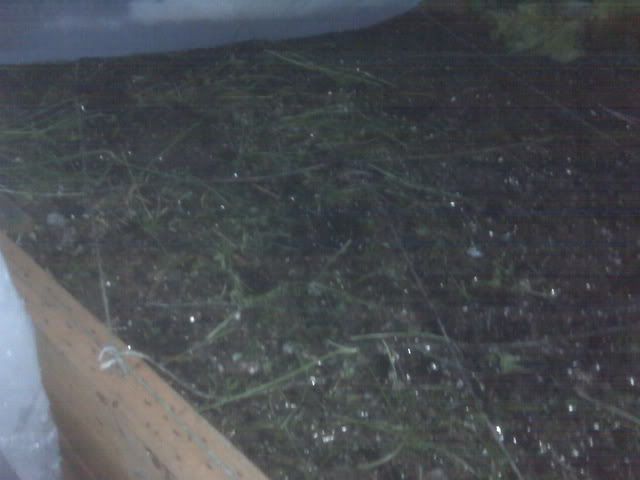
Where have all the carrots gone, cold frost passes... /sigh. I have no idea if the carrots below ground are still there and edible. I think they very well may be. I've read that a freeze is great for carrots, that they horde sugars for the long-haul, and that makes for candy carrots. Soon I will dig up the biggest and share them with my eldest to taste-test that research, hehe. One possible bright spot in all this, and one of my attempts to be a half-full-glass type of guy.
Further back in the garden, the devistation of temperatures in the teens is evident with the lettuce.
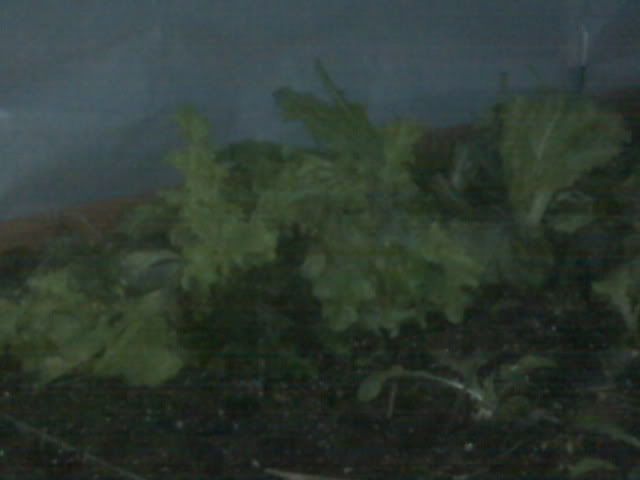
Again sorry for the photo quality, I didn't go out until we were heading out shopping at dusk and basically stuck my arm under the cover, aimed in the general direction and took the picture. Anyway, you can easily tell just how wilted the lettuce is. I seriously doubt warm temperatures will bounce these guys back. I sure hope I'm wrong though, because NOW I'm craving a salad. Must be my vacation and not being able to walk to a salad place for lunch a few times a week. I know, shame on me.
Well, I'm still holding out hope for my succession lettuce. They don't look nearly as bad as my mature earlier planting, and may very well bounce back with the new growth (whenever that happens).

Undaunted, I moved on to bed #2, only to find much of the same.
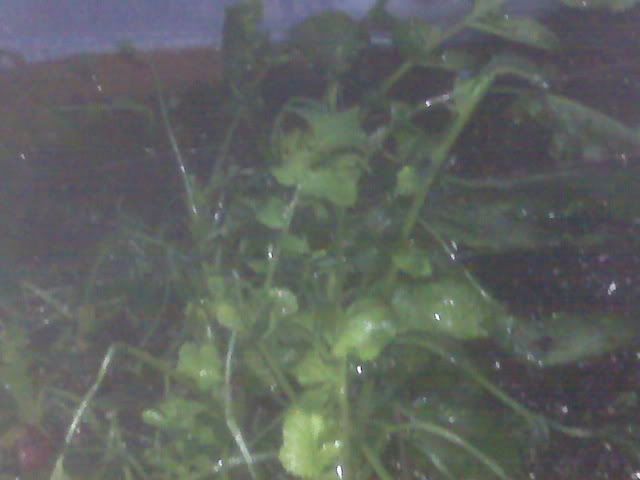
This unintentional close-up is of my wilting raddish greens. You can see in the bottom left corner a red raddish poking out. I fully expect that most of my raddishes are ok below ground, though many may be cracked and bitter. My fault for not eating them with DoubleD told me to, hehe.
Moving deeper into the bed, my lush and vibrant spinach now looks like this...
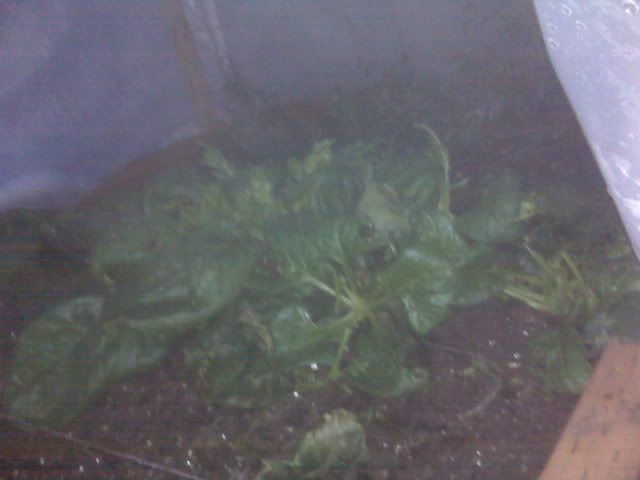
Pretty sad, I know. But at least the Spinach Leaf Miners don't like the cold either, their population has diminished greatly. hmmmm?!?
Ok, I know, I know, EG will shake his head in disgust, but I'm including all my pictures in one post. You'll see why later on in this mega post.
Moving to the last bed (#3), I was pretty resigned to the worst, but still, cauliflower are cold-tollerant plants, right?
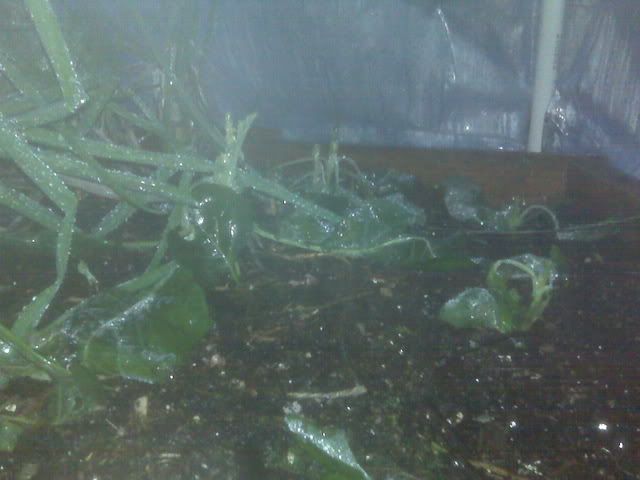
I fully expect to see new growth to recover from this, much like the munched leaves earlier being eclipsed by new healthy growth after the organic parasites did their number on whatever was eating them. See, I'm being optimistic, hehe. And I guess another bright spot is on the left hand side of the above picture. Neither August heat, nor sub-freezing temperatures can dent my green onions. They are truly the wonder plant of my garden. Not sure how they'll taste. My wife bought some rather than try them. I guess I'll have to pick one and taste test it for her. Gladly.
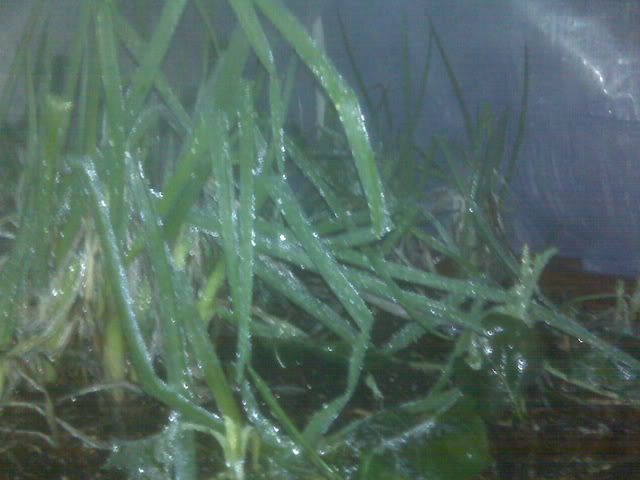
Well, that wraps up my latest (and possibly last this season) garden tour. But this post doesn't end there. What's left you say? Well, an email from my local library told me that I couldn't auto-renew the Four Season Harvest book anymore, so it was time to finish it or return it unread. As you seasoned reader of this blaugh well know, I've not been too keen on this book. It's clearly written for the Northeastern gardener, or French gardener, but certainly not the PNW, or any other area of the country garden enthusiast. Still, I tried to take a few snipets of good information from it, mostly to make it worth my time. But I must say, the last chapter was INCREDIBLE. If only the whole book was like that, it would be on my shelf like it is Patti the Garden Girl's (Bostonian that she is). The last real chapter of the book is on insects, both beneficials and pests. Eliot Coleman takes a true organic approach to them. He believes and backs up with research and the experience of others, in a balanced approach to insect management. I've read this before, that insects in harmony will balance each other out by beneficial insects preying on their pest brethren such that neither gain dominance. What I hadn't heard before was that an over-abundance of pests in the garden is more a symptom of something wrong with your soil conditions, or the health of the plant. Similarly in nature, pack predators feed on only the weak or sick of a herd. So, thinking this way, you would see pests as a symptom of someting wrong with the plant or soil and fix that rather than further damage the balance by using chemicals, or even orgainic pesticides. Definitely something to research further and think about next time I reach for the Spinosad, BT or DE.
If I have time before I have to return the book, I will search for more useful tid bits from the appendix of all the vegetables and how best to grow them, etc.
Summarizing the book, I believe it is very similar to Steve Solomon's Growing Vegetables West of the Cascades if you're in Alabama, not very useful.
Well, that's about it for tonight. My next post will be a reader request. Carolyn from Oregon has requested a post on Monsanto. Rather than my last post where I simply stated my loathe for the company and went from there, I will try to educate and explain my opinion. Hehe, I know, you didn't like my last post on it, and I swore to keep politics out of my blog. But hey, I doubt I can depleate my readership any more than winter has. hehe, I'm down to less than 100 readers a day now. Who cares, my main goal with this blog was to keep record of my mistakes and successes so I could learn from them in years to come.
Enjoy your garden, if you still have one after this wacky weather North America's had lately. If you don't, enjoy the catalogs that should be pouring in about now, I know I am (but that is another post).
Awww, Sinfonian, I'm so sorry your winter garden is toast. I'm holding out hope for those carrots, though. The ones I dumped on the ground trying to transplant to a larger pot ended up with completely dead tops. I didn't dig them back out, and now they have lots of new growth showing. Hopefully yours just top killed and the root is still just fine.
ReplyDeleteWith your beds being raised like that, it's possible that the soil froze, which is going to kill most anything you're growing. Ironically they may have done better without the cover as a layer of snow has an insulating effect. I reached thru the snow on several occasions and found my garden soil underneath to be quite soft, not frozen. My leeks appear to have come thru this just fine unprotected, and my Rutabagas did fine but I covered them with plastic. These two crops are completely dormant, basically in live, cold storage. Getting anything to actually grow in northern winters, without electric lights and heat, I personally believe is a waste of time. Although I've been checking your blog for evidence one way or the other. Only a couple more months before we start it all over again!
ReplyDeleteAre you really 8b? We are 7/8 here in ETexas and our weather has been so normal!! No wonder you were so surprised with the snow fall!! Take care, and keep gardening:)
ReplyDeleteSeeing your pics reminded me of the carnage my fall garden experienced. I went ahead and pulled my carrots too, because the last cold spell did them in. Oh well....i'll give it another try, once the current seedlings are ready. Like you, i've also read about pests doing more damage to plants that aren't healthy. I'm still gonna take it to 'em, though! I like killing squashbugs!
ReplyDeleteEG
I am positive your carrots are just fine. The tops DO die back with the cold - but the roots are protected by the soil and they will continue to hold and be harvestable until the soil begins to really warm up and the day length gets noticeably longer - at which point they will start getting "hairy" with new root growth followed shortly there after by an attempt to bolt to seed. But you will have cleaned them out (or eaten them all!) by then so no worries. We are digging carrots and parsnips out of the snow encrusted beds regularly and do every winter.
ReplyDeleteYou rock! TY much for the Monsanto post. I haven't made up my mind what I believe yet, I'm trying to be open minded and research before I come to a conclusion. I'm not sure it matters for me: I'm growing all heirlooms anyway AND I have mad love for Baker Creek and tomatofest, lol.
ReplyDeleteI thought all my chard was dead because it all froze solid in a casing of ice in front of the house. After the defrost, it is all fine. Weird, no? Maybe some of yours will come back.